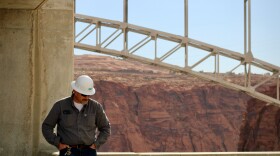The latest projections for the Colorado River are out, and they paint a picture of more dry conditions and dropping reservoirs.
The river supplies water to nearly 40 million people across the Southwest, and it’s stretched thin by climate change and steady demand. New data from the Bureau of Reclamation shows low inflows and dropping water levels at the nation’s two largest reservoirs – Lake Powell and Lake Mead. This is just the latest bad news in the midst of a megadrought going back more than two decades.
Get top headlines and KUNC reporting directly to your mailbox each week when you subscribe to In The NoCo.
The river will enter 2026 in a “Tier 1 Shortage,” under which Arizona and Nevada will face mandatory cutbacks to their water supply. While they put some water users in an uncomfortable pinch, those cutbacks aren’t raising the same alarm bells they once did. Dry conditions and water reductions have become a sort of new normal. Shortage conditions for the lower Colorado River basin were first declared in 2021, and have been in place since.
On the ground, the agencies that have to deal with these cutbacks seem to be adapting. Major water users tout their conservation efforts. The towns and cities that are most likely to face permanent reductions to their water use are putting hundreds of millions of dollars into systems that will steel them against smaller water deliveries in the future.
Meanwhile, further upstream, dropping levels at Lake Powell are creating a near-term crisis. The new federal water data shows the reservoir ending this year only 27% full. If it drops much lower, the reservoir could fall below the pipes which allow water to flow through hydropower generators inside the dam – jeopardizing electricity generation for about five million people across seven states. The new data shows that could happen as soon as November 2026.

Policymakers who can shape the region’s long-term response to dry conditions have been facing mounting calls for action. They are under pressure to come up with new rules for managing the river in the long-term before the current guidelines expire in 2026.
Cynthia Campbell, who directs a water policy research center at Arizona State University, said instead of urgently working on a long-term plan, those policymakers seem to have spent the past few years “gambling” on the idea that water might come back and reverse the crisis at major reservoirs.
“If they were betting on that,” she said, “Then they're losing, because it is continuing to march on. Mother Nature is continuing to march on, and we're continuing to see declines in the system.”
While some small glimmers of hope have emerged from negotiations, water managers from the seven states that use the Colorado River seem stuck at an impasse.
“We have yet to see any courage in the sense of making choices that will bolster long-term system reliability,” said Campbell, who formerly served as a top water lawyer for the city of Phoenix. “There seems to be an unwillingness on the collected parties to do that, and that is not good news.”
Climate scientists say the river’s dry conditions are unlikely to turn around anytime soon. A warming, drying climate is sapping the region of its water at every turn, and significant reductions to demand are likely the only solution to that new reality.
This story is part of ongoing coverage of water in the West, produced by KUNC in Colorado and supported by the Walton Family Foundation. KUNC is solely responsible for its editorial coverage.





